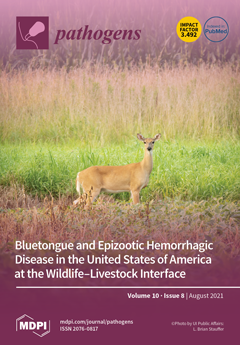While hybridization probe-based real-time PCR assays targeting highly repetitive multi-copy genome sequences for the diagnosis of
S. mansoni complex or
S. haematobium complex from human serum are well established, reports on the evaluation of respective assays for the identification of
S. japonicum complex
[...] Read more.
While hybridization probe-based real-time PCR assays targeting highly repetitive multi-copy genome sequences for the diagnosis of
S. mansoni complex or
S. haematobium complex from human serum are well established, reports on the evaluation of respective assays for the identification of
S. japonicum complex DNA in human serum are scarce. Here, we assessed the potential use of the retrotransposon sequences
SjR2 and
SjCHGCS19 from
S. japonicum,
S. mekongi and
S. malayensis for the diagnosis of Asian
Schistosoma infections. Based on available
S. japonicum sequences and newly provided
S. mekongi and
S. malayensis sequences, hybridization probe-based real-time PCRs targeting
SjR2 and
SjCHGCS19 of the
S. japonicum complex were designed both as consensus primer assays as well as multi-primer assays for the coverage of multiple variants of the target sequences. The assays were established using plasmids and
S. mekongi DNA. While the consensus primer assays failed to detect
S. mekongi DNA in human serum samples, the multi-primer assays showed positive or borderline positive results but only in 9.8% (6/61) of serum samples from patients with confirmed
S. mekongi infections. Some cross-reactions with samples positive for
S. mansoni or
S. haematobium were observed but with the
SjCHGCS19-PCR only. In spite of the low sensitivity, the presented experience may guide future evaluations of
S. japonicum-complex-specific PCRs from human serum.
Full article






